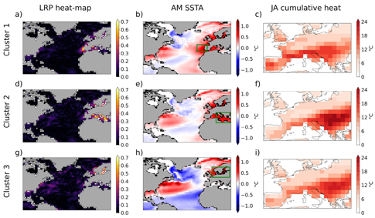Spring Regional Sea Surface Temperatures as a Precursor of European Summer Heatwaves
Collaborator Prof. Elizabeth Barnes (Colorado State University) and co-authors train neural networks to predict the occurrence of European summer heatwaves and use explainable machine learning algorithms to diagnose their springtime sea-surface temperature precursors using 100 historical simulations of the MPI Grand Ensemble. A neural network is tasked to predict whether a summer heatwave (i.e. integrated cumulative heat over Europe exceeding a predetermined threshold) will be present in summer, given sea-surface temperatures in spring. The network correctly classifies approximately 70% of all heatwaves/non-heatwave seasons. The authors then cluster the resulting samples for when the network is confident in its prediction to show three different sources of predictability (from spring sea-surface temperature maps) that lead to three regional patterns of heatwaves over Europe.
Although the machine learning algorithms are trained to predict heatwaves in the coming months, the main focus of the article is on heatwave precursors, which are identified via explainable machine learning algorithms. Results show three “flavors” of European heatwave, each with different regional sea-surface temperature anomalies that act as precursors. In this way, the work demonstrates an approach to predicting (and understanding) the lead-up to dangerous summer heat waves over Europe.
The authors investigate spring North Atlantic sea-surface temperature anomalies as a precursor of European summertime heatwaves by combining the historical MPI Grand Ensemble data set with neural-network-based explainable machine learning methods. Specifically, neural networks are trained to take spring-time, North Atlantic sea-surface temperature fields as input and use them to predict whether a European heatwave will occur the following summer. Although the network is only tasked with predicting a binary “yes” or “no”, it is able to learn multiple types of regional European heatwaves, as well as their different sea-surface temperature precursors. These regional sea-surface temperature precursors can be related to distinct anticyclonic anomalies in spring, reducing the precipitation and leading to distinct patterns of negative SM anomalies in early summer. This work highlights a data-driven approach to predicting (and understanding) the lead-up to dangerous summer heat waves over Europe.

